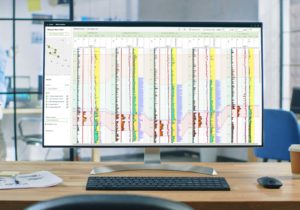 “I was on the runway at DFW, and from my XSPOC software mobile app I was able to rock start an ESP to get it started and free up a stuck pump—while my airplane was ready to take off.” Shelby Williams of ChampionX loves to tell that story because it illustrates what IT and automation bring to the fingertips of everyone in the oil patch. Automation provides a large amount of asset control “from, essentially, anywhere in the world.” Williams is a remote monitoring and optimization services manager for the company. XSPOC is ChampionX’s production optimization software.
“I was on the runway at DFW, and from my XSPOC software mobile app I was able to rock start an ESP to get it started and free up a stuck pump—while my airplane was ready to take off.” Shelby Williams of ChampionX loves to tell that story because it illustrates what IT and automation bring to the fingertips of everyone in the oil patch. Automation provides a large amount of asset control “from, essentially, anywhere in the world.” Williams is a remote monitoring and optimization services manager for the company. XSPOC is ChampionX’s production optimization software.
This control and optimization is made possible by a flood of data and communication unheard of as recently as 10 years ago. At that time, Williams notes, datapoints were recorded once an hour, and most were not immediately transferred to a central database.
Now a thousand datapoints per minute flood IT departments across every basin, from all kinds of operations 24/7. Fortunately, as in the Williams story, artificial intelligence (AI) is harnessing the power of computer analysis to channel that data into useful streams in every oil and gas department. This is giving industry decision makers more and more tools with which to improve efficiencies and boost production—perfect timing for an uncertain market for both capital and product demand.
Workforce shortages and the Great Crew Change—the loss of experience as older workers are replaced by recent graduates—have pushed more producers to embrace automation, Williams said. Fluctuating oil prices and ESG concerns are also driving the migration to automation/autonomous operations.
A lot of producers “are stepping away from their manual ways,” she observed. “They’re investing heavily in automation solutions. That’s been a major shift I’ve seen over the past five years. Automation is getting the recognition and notice it deserves.”
Now the industry is moving toward autonomous control out of necessity. Today, each production engineer may be responsible for hundreds of wells due to staffing shortages.
It is here that technology plugs in to bridge the gap created by constant layoffs/rehires and the aforementioned Great Crew Change. Longtime workers may be overwhelmed by the influx of technology, but new workers cling to that technology to keep from being overwhelmed themselves, in that case by the massive amount they have to learn. Machine Learning has done much of that for them.
“It can help bridge the gap that we currently have in the industry when it comes to knowledge,” Williams said. “We see a major gap between the younger generation and your 15-25 year veterans. That hands-on industry experience and years of tribal knowledge are missing.” In addition to the gap, “we don’t have near the new engineers coming in,” she said. Those new engineers are needed if the patch is to maintain the worker count as the older generation retires.
This is one of the biggest reasons companies are compelled toward automation and autonomous operations. Here’s where the industry is on that scale.
Current autonomous algorithms are focused on set point optimization. “We have various algorithms built out to monitor performance and make adjustments to your operations autonomously. Eventually you’ll have full autonomous capability,” Williams said. AI-enabled features in the software can also monitor longer term operations to optimize preventive and predictive maintenance, including PMs in chemical injection systems.
On one level, the idea of computers running everything sounds scary, but end users can require the level of human input they’re comfortable with. Some of the comfort level can depend on the engineer’s generation. “You have the hybrid engineering staff,” Williams said, “where some of them are wanting that manual input.” In that scenario the software makes set point recommendations that can be accepted or rejected by the engineer. Others are open to allowing algorithms closed-loop control to make the changes without human intervention.
While any system involving humans—directly or through a system humans designed—is going to be imperfect, Williams pointed out that autonomous operations are far ahead of the days when a pumper visited the site every few days, too often driving up to a problem that had been unnoticed for 24-72 hours.
Automating Subsurface Data Management
“The one thing that I think everyone in the industry’s trying to really get a handle on is subsurface data, and the one thing the industry does not lack is volumes of subsurface data, particularly in the Permian,” said Chris Hanton, VP of data solutions for Ikon Science. The company provides knowledge management solutions and consultative data services around the world.
“The Permian,” he continued, “is a very mature basin that’s been worked on for multiple years, so there’s a huge amount of data flowing out there.” He referred to “mountains of data” being generated by seismic equipment geoscientists and engineers as well as wireline/wellbore data. “That data can only add value to the organization if it can be utilized.”
Ikon has partnered with some companies who are leading the way in harnessing that data, Hanton noted. They are addressing “this idea of being able to extract information from reports, and then being able to relate it using natural language queries so you’re able to extract the context of the insights that are most valuable to you.” AI makes that enlightenment possible without requiring geoscientists to first pore over thousands of pages of information.
 Clear geological information can inform decision making such as drilling, completions, safety, and, ultimately, the company’s bottom line.
Clear geological information can inform decision making such as drilling, completions, safety, and, ultimately, the company’s bottom line.
One of the main issues with processing data is keeping it from being siloed in separate data platforms, meaning that no one has access to all of it. Geodata comes from multiple sources: seismic (possibly more than one of those); drilling data; and then there are analyses done by various geoscientists over the years. Making it all available in one centralized platform is the purpose of Ikon’s knowledge management solution, Curate.
“Curate has the tools to seamlessly link to these data platforms and then provide the tools to geoscientists to see within that centralized location how that information relates to other versions.” Its goal is also to make that data available to all departments that are involved in decision making, giving the whole team the tools necessary for making the right decisions financially as well as procedurally.
Sometimes the various sources of data in an area may be in conflict, depending on when and how they were acquired. While this is somewhat of a dilemma, Hanton said, “All models are wrong, that’s the number one thing to understand. So you’re constantly striving to improve those models. The way we do that is that we get more data, higher quality data, as we maybe shoot higher quality seismic and maybe fill in those gaps a little bit more.” He added, “The rocks may not change but our understanding does.”
Tapping the Brakes on ‘Drill, Baby, Drill’
The more wells that are drilled in a formation, the more scrutiny there can be even on existing data. In a field where large numbers of wells are drilled, Hanton said, there may be a few that don’t perform as expected. Geoscientists may ask whether there is a subsurface anomaly near those wells or if the problem is with data quality. “Based on that, it changes how I as a geoscientist deal with that.” It could be that there is a slight, previously unnoticed anomaly in the formation.
Anomalies occur more often in unconventionals. He noted that “drill, baby, drill” works only as long as all wells are drilled into a homogenous subsurface. But the previously extreme drilling volume created a corresponding high volume of data, which geoscientists struggled to manage in order to better target sweet spots or to make drilling procedures more efficient.
Using this data to better understand fluid dynamics has a safety aspect as well. Better predicting downhole pressure can prevent dangerous and deadly blowouts as bits reach producing zones.
In addition to data and information technology providing tools for decision making, it’s providing tools, period. Autonomous operations, in which more and more decisions are made quickly and, hopefully, efficiently while just informing humans of what was done, is no longer a dream. More and more tasks are being done this way.
Ravindra Puranik, Oil and Gas Analyst at GlobalData, a London-based managed IT service company with offices around the world, including Texas and Louisiana, says this trend will only grow. In an email interview he said, “Digital twins/robotics/predictive maintenance are available. Now the industry is gradually moving towards unmanned oilfields, unmanned drilling, [and] prescriptive maintenance.”
He continued, “Machine learning and deep learning tools with big data analytics, cloud computing, [and] faster servers will help develop autonomous processes in the industry. The larger data set, along with huge computational power, will facilitate creating autonomous processes. Initial deployment will be slow, but any successes therein will be fast replicated across the industry. So data mining from IoT-powered datasets will push autonomous operations.”
As has been true since the start of the industrial revolution in the late 18th century, new machinery/technology requires new datasets from workers. Puranik noted that automation does not always end jobs, but it does usually change them. The workforce that adapts to robotic operations like drilling platforms will have to be more technically adept “to deal with data and operations. The physical workforce will decrease and the technical workforce will increase in the long run.”
For those who can adapt, there is good news. “Rather than pushing out the workforce, the industry will attract a workforce with diverse technical skillsets,” he said.
If the possibilities are endless, so are the needs. As incredible as they were, the days of NASA using “Hidden Figures” humans with punchcard-driven computers to get people to the moon have been washed away in the dataflood tsunami. Only electronic systems can collect, manage, and mine that data—but when those systems are properly programmed they offer great riches in actionable information.
For the workforce, the tsunami lifeboat is in retraining. And flexibility.
__________________________________________________________________________________________________
Paul Wiseman is a freelance writer in the oil and gas industry. His email is fittoprint414@gmail.com.









